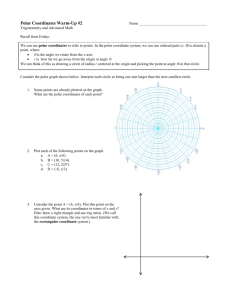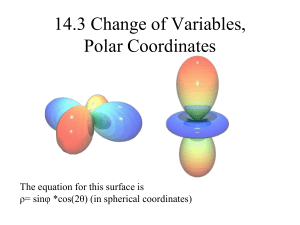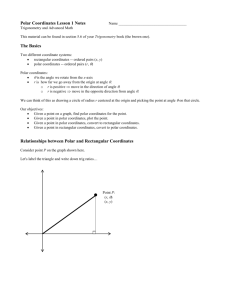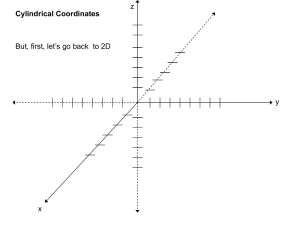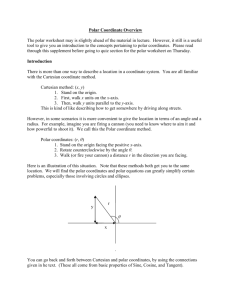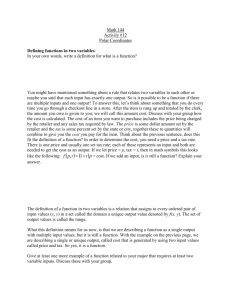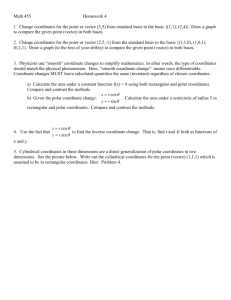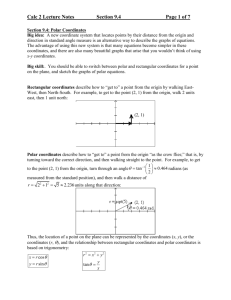Polar Coordinates
advertisement
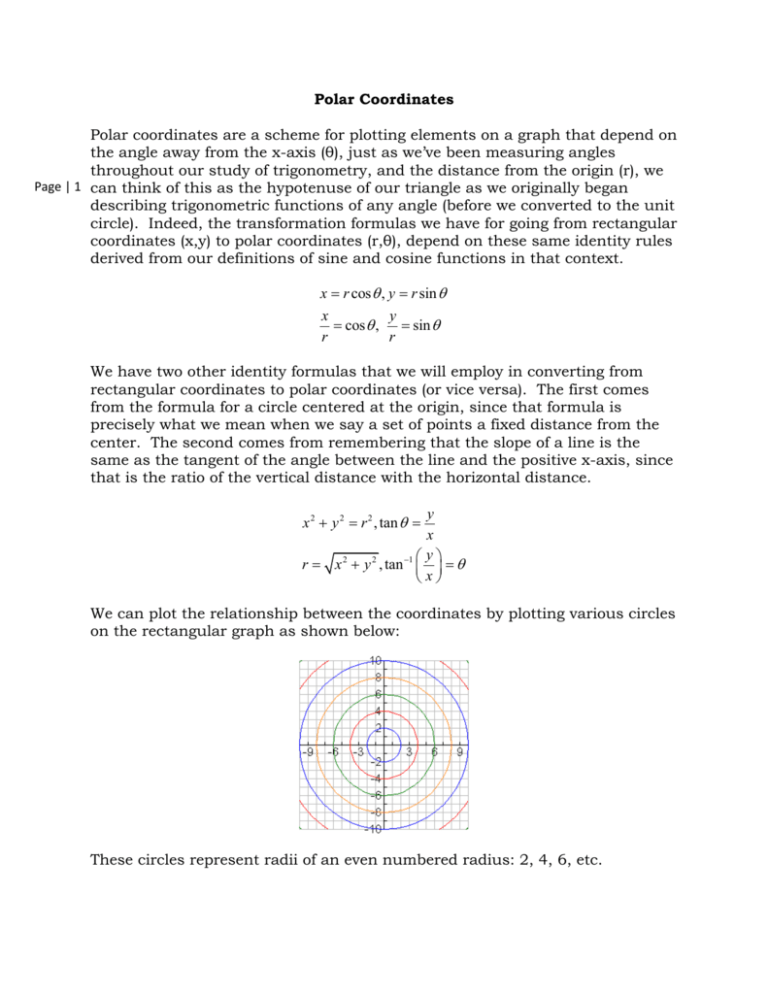
Polar Coordinates Polar coordinates are a scheme for plotting elements on a graph that depend on the angle away from the x-axis (θ), just as we’ve been measuring angles throughout our study of trigonometry, and the distance from the origin (r), we Page | 1 can think of this as the hypotenuse of our triangle as we originally began describing trigonometric functions of any angle (before we converted to the unit circle). Indeed, the transformation formulas we have for going from rectangular coordinates (x,y) to polar coordinates (r,θ), depend on these same identity rules derived from our definitions of sine and cosine functions in that context. x r cos , y r sin x y cos , sin r r We have two other identity formulas that we will employ in converting from rectangular coordinates to polar coordinates (or vice versa). The first comes from the formula for a circle centered at the origin, since that formula is precisely what we mean when we say a set of points a fixed distance from the center. The second comes from remembering that the slope of a line is the same as the tangent of the angle between the line and the positive x-axis, since that is the ratio of the vertical distance with the horizontal distance. y x y r x 2 y 2 , tan 1 x x 2 y 2 r 2 , tan We can plot the relationship between the coordinates by plotting various circles on the rectangular graph as shown below: These circles represent radii of an even numbered radius: 2, 4, 6, etc. In the graph below, we can separately graph some of the common radial lines that represent various angles of θ. Typical polar graphs use angles that are multiples of π/12, since that will cover all the common values, plus a few extra values at conveniently-spaced intervals. The equations that produce the lines in the first (and third) quadrants are (approximate in some cases): y 0 , Page | 2 1 5 y tan x , y x , y x , y 3x , y tan x , x 0 . The values in the 3 12 12 second quadrant are just the negatives of these same slopes. You should be able to recognize the lines that represent our standard angle values. Plotting points in Polar Consider the point 4, . In order to plot this on the graph, we are going to 3 first find the angle π/3 (recall that this angle is the same as 4π/12) and the line that represents it, and then count out from the center using the rings marking the radii until we get to the one marked 4. In a more detailed polar graph (and a bigger one) more radii will be explicitly labeled. In our examples, we will approximate locations for any points not on one of the labeled radii. Think about drawing an imaginary circle to find a good spot. The graph below labels the point. Notice the black dot? 11 Let’s try another. Say 6, . In this case, the angle is larger than 2π, so we 4 have to count all around the circle and then finally stop at the line equivalent to 3π/4. This fact means that unlike in rectangular coordinates, points do not have unique coordinates in polar, since every time one makes a complete circle, Page | 3 all the points are repeated again. There is an infinite number of ways of writing the coordinates for any given location. Most of the time we will work with angles between 0 and 2π, but occasionally, it will be necessary to use values outside this range. Indeed, negative angles will mean we count in the opposite direction (the equivalent angle for this point is -5π/4). Another complication is that while radii are typically represented as positive, they can be represented as negative values as well. This will sometimes happen when we start to work with equations, so it’s important to mention here. Consider the point 8, . When we go to plot this point, we will begin 6 as we did before. Find the radial line representing the angle π/6. Normally, if the radius was positive, we would count outward from the origin as if there was an arrow on the π/6 line pointing away from the origin. However, the negative radius means that we are going to count away from the origin in the opposite direction, along the radial line π more than the specified angle, in the third quadrant rather than the first. The arrow on the graph points in the direction of the positive radius. This 5 point is equivalent to 8, . 6 Page | 4 Converting Coordinates. Sometimes it will be convenient for us to convert from polar coordinates to rectangular coordinates or vice versa. We can do this if we wish to check our plots in polar. But, mostly, it will be preliminary to convert equations from one system to the other. At this point it will become clearer to us why polar coordinates are extremely useful. Let’s consider the three points we’ve plotted so far and convert these to 11 rectangular coordinates: 4, , 6, , 8, . To do this, we will use the 4 6 3 identities we introduced at the beginning: x r cos , y r sin . We work out the rectangular coordinates for all three points below. 4, : x 4 cos 2, y 4sin 2 3 : 2, 2 3 3 3 3 11 11 11 6, : x 6cos 3 2, y 6sin 3 2 : 3 2,3 2 4 4 4 8, : x 8cos 4 3, y 8sin 4 : 4 3, 4 6 6 6 Compare these coordinates to the x-y gridlines in the background of each of our graphs. The graphs of each point should match up. The most obvious feature should be that they are all in the appropriate quadrants, even the third one with the negative radius. You can check for yourself that the equivalent coordinate pairs I mentioned for each of these points also produces the same set of unique x-y coordinates. Incidentally, you can use degrees in plotting points in polar, but degrees must be clearly labeled as degrees. Without a degree symbol, the points are assumed to be in radians. We will keep things in radians for that reason. Now, let’s go in the other direction. Suppose we want coordinates in polar for points given to us in rectangular (for whatever reason). The other pair of conversion formula will be useful here. Let’s convert the following points: (1,1), (3,-2), (-7,-5), (-2,1). We know what quadrants these points must be in, and we will need to use that information to get the right angles. We will use the standard coordinates with a positive radius and angle between 0 and 2π. Because our angles are unlikely to be common angles in all cases, we will approximate the angles to four significant digits. 1 (1,1) :12 12 2, r 2; tan 1 : 2, 4 1 4 2 (3, 2) : 32 ( 2) 2 13, r 13; tan 1 0.5880 5.695 : 3 Page | 5 13,5.695 7 ( 7, 5) : ( 7) 2 ( 5) 2 74, r 74; tan 1 0.9505 4.092 : 74, 4.092 5 1 ( 2,1) : ( 2) 2 12 5, r 5; tan 1 0.4636 2.678 : 5, 2.678 2 The first point converted nicely, but the others required tinkering that depends on properties of the point and the inverse tangent function. The second point would have been okay with the angle produced by the inverse tangent if we had not specified in advance that we wanted angles between 0 and 2π. Since this angle was negative (in the fourth quadrant), I simply added 2π to get it into the required range. For the second two points, I added π to get the angles into the second and third quadrants. It certainly would have been acceptable (if nonstandard) to simply make the radius negative instead, again, if I had not specified in advance that I wanted to keep the radius positive. To plot these points in polar, it will probably help to convert the square roots to decimal approximations, and on your polar graph paper to convert the radian angles in multiples of π/12 to decimal equivalents. Except for the first point, none of these will fall exactly on any radial line. Converting Equations The next step up is that we want to use our conversion formulas to convert polar equations to rectangular equations, and vice versa. We will return to plotting equations in polar coordinates in a bit. Consider the rectangular equation ( x 5)2 y 2 9 . This equation is a circle centered at the point (5,0) with a radius of 3. To convert this to polar, we will need to multiply it out and convert it to the general form of a circle. Here, we get: x 2 y 2 10 x 16 0 . Now we can use the identities to convert: r 2 10r cos 16 0 . In order to graph this in polar form (in our calculators, say), we would have to solve for r, which would be a real challenge for this equation. Our main concern in this section will be to eliminate any x- or yterms from the equation and replace them entirely with r- and θ-terms. To go in the reverse direction, consider the polar equation r 3cos . In this case, it will help us to multiply the equation by r (this is a common trick that will help you going in this direction). If we don’t do that, we can replace the left side in terms of x and y, but with a nasty square root; plus, what are we to do with that bare cosine? Doing this trick we obtain: r 2 3r cos . At this point, the substitution is much easier: x 2 y 2 3x . If we wanted to graph this circle, we could move everything to one side and complete the square of x. The number we get might not be pretty, but we will encounter far worse equations. I this simplifying as an exercise for the reader, but recall that as functions, you Page | 6 would need one for the top half of the curve, and one for the bottom half. Much less elegant than the very simple polar equation we began with. Graphing Polar Equations To graph a polar equation, for instance, r=2-4cosθ, we choose values of θ and use that to calculate the size of the radius. That gives us a point to plot. Most polar graph paper has radial lines (for θ) at multiples of π/12, and these are usually ideal values to use in plotting. Depending on the graph we may want to choose angles at π/24 (angles midway between the given radial lines); graphs of this type include multiples of θ, such as r=cos(2θ), or r=cos(4θ), because of the intricacy of the graphs we are plotting. Another useful plotting technique is to draw graphs as large as your graph paper will allow. Few things are more frustrating than trying to grade a graph that is drawn smaller than a dime on an entire sheet of graph paper! The following series of graphs shows the development of the graph of r=2-cosθ. Plotted on the first graph are θ=0, and θ=π/12, and the dots are connected. Then subsequent graphs plot subsequent multiples of π/12: π/6, π/4, π/3, 5π/12, π/2, and so on through the entire graph until we come back to 2π. Plot the points as you go. Note carefully that some of the radius values will be negative. Page | 7 One method of aiding your graphing of polar equations is to graph the equation initially in rectangular coordinates, with r being replaced by y and θ being replaced by x, i.e. graph y=2-4cos(x) in this case. This graph can be graphed by transformations as shown below: You can use the values of y on your graph to help you plot the values of r on your polar graph. You can even set your calculator to show gridlines or tick marks at intervals of π/12, or use your table values to obtain the radius values in decimal form. We are more familiar now with graphing transformed trig functions in rectangular format, and that can tell us something about what our Page | 8 polar graph is going to look like. Will the radius ever be negative? What is the maximum or minimum value of the radius? Does it complete more than one cycle in 2π radians? And so on. Problems. i. ii. iii. On the attached polar graph, plot the following points: 2 5 5 8 17 9 1, , 2, , 3, , 4, , 5, , 6, , 7, , 8, 3 4 6 3 6 12 2 Convert the points in (i) to rectangular coordinates. Convert the following points to polar coordinates: 1 5 9 ( 1, 2),( 3, 3), 4, , 5, 17 , 3,1 , 4, 5 , 10,11 , , 2 3 2 Convert the following functions in rectangular coordinates to polar coordinates. Try to solve for r if possible (or θ if r cancels out). a. x 2 y 2 4 x 6 y b. y 5x iv. v. c. x 2 y 2 0 d. x 4 e. ( x 2)2 ( y 3)2 16 Convert the following functions in polar coordinates to rectangular coordinates. Solve for y if possible, or put into standard form (if some known shape). f. r 2sin g. r 3 sin h. r 6sin 2 2 j. r 3 k. r 5csc For each of the graphs in (v), plot each on a polar graph. You may want to print out additional graph paper sheets (I’ve only attached two). You should do these by hand! You can compare your graph to your calculator, but you should label every point you plot with exact values. For at least one of the graphs, trying graphing in rectangular form first. (If it helps, do it for all the graphs. If not, you can stop after one.) i. vi.
